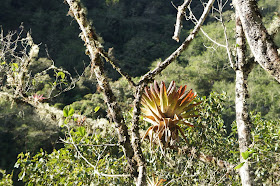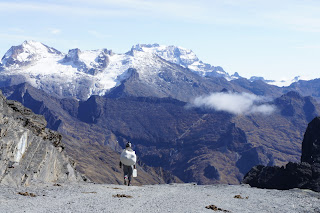 |
| Old man walking down the mountain side with what seemed like an extremely heavy backpack |
This weekend me, Dorte and her boyfriend Asger went to check out the Bolivian wildlife through the so-called
El Choro-trail. The approximately
53 km long trek starts in
La Cumbre, a place which lies 45 minutes by car from La Paz. Our goal was the mountain-side village
Coroico, which lies about 3 hours away from La Paz by car. The distance might not seem that long, but you have to cross over rivers, ascend and descend mountains, and not to mention the winding paths will take you zig-zag all the way to Coroico.
 |
| Starting out with a break on the top of the mountain. |
Going to Coroico takes you through
5 different climate sones, from the cold and naked mountains close to La Cumbre, and a change to low altitude and hot climate when you get closer to Coroico and the Amazon jungle. The big variation definitely made the trek even more amazing.
 |
| Ready for the unknown.. Oh yeah.. ;p |
We started of fresh at more or less 9 o'clock at Friday, with nothing but ourselves, our backpacks and our local guide Andres (we soon gave him the nickname "Tarzan" because of his toughness..!).
The first thing we did was to climb up one of the mountains close the the lakes in La Cumbre, and from there we had a great view of some inca ruins that Andres told us is more than 500 years old. As we went down towards the ruins we could see condors flying high above us, which actually is quite rare cause they prefer to stay at even higher places. But after we had passed the inca ruins we soon understood why the birds were patrolling the area: a horse cadaver by the side of the road..
We did see a lot of other living animals too though; both wild horses, llamas and sheep were to be found in this area.
 |
| Inca ruins that supposedly are more than 500 years old |
 |
| We had to register before going through Samana Pampa |
After some hours of walking we came to the small village Samana Pampa which we just passed through after having registered ourself in a local office on the way.
We did not see many people on our way, and the fog limited our view.
In the village Chucura, which is situated 3600 o.s.l, we had a quick stop to eat lunch. They were celebrating the jubilee of the village, so while eating we could hear sounds of a fiesta in the neighbourhood even though we couldn't see anything.
 |
| Our guide walking through the foggy landscape |
 |
| Asger taking a rest after more or less 4-5 hours of walking |
Our next stop was Challapampa, and this was were we spent the first night. One of the local ladies, who knew our guide, made us dinner, and afterwards we went to bed. I think the clock was around seven or eight in the evening, but all of us were really tired after the long day..
 |
| The first toilet we passed on our trip.. |
 |
| First view of Challapampa |
 |
| The tent is ready for the night..! |
 |
| Dinner at the house of a local lady living at Challapampa |
The second day of our trip we got up before sunrise, an started heading further down the mountainsides. The climate changed quite quickly, and it was a lot more humid than the day before. Most of the day we spent walking through exotic vegetation, we bathed in a river and saw a lot of exotic butterflies. Today we also had to climb the "Cuesta del Diablo" (or the hill of the devil), which is said to be the hardest part of the El Choro track. There was a part after it though, where the guide speeded up so badly that the Cuesta del Diablo seemed like a joke.. Haha..
But also today, we had great views and a lot to see.
 |
| The three of us ready for another hard day! |
 |
| Some interesting plant |
 |
| Just relaxing by the river |
 |
| While we were bathing in the river a butterfly used the chance to rest on a pair of our socks. |
 |
| Passing the little rest-area called Buena Vista, which means Nice View. And there was certainly a lot of nice view here:) |
 |
| We passed some gold mines on our way too; here there were 4 men working in the mines. Can't really say they had a lot of security in there though.. |
 |
| With a lot of walking to do you better rest while you can.. |
 |
| But there is also time to enjoy the view! |
 |
| ..Some of the bridges we crossed didn't seem too safe to be honest.. |
After another long day with 5-6 hours of walking we arrived at a village called Sandillani where there currently wasn't anybody, except for a 80-something year old Japanese man called Hanamura, who lived alone up in the mountains with his dog. Apparently he came to Bolivia from over 60 years ago; I tried to talk to him in Japanese but he didn't really answer a lot. I guess he wasn't used to talking it after all these years. I told him I live in Kyoto, and he started talking about the years Kyoto was the capital, he seemed to have remembered a lot of dates..
 |
| A Japanese house in the middle of nowhere - gokk-mokk - Bolivia |
 |
| The guide cooking some noodles for us for dinner |
 |
| Our place for the night. According to Dorte there were bats flying around us during the night, probably to catch the mosquitoes that had gathered to get a meal.. |
Anyway, that night we slept on the ground without the tent, and we could see the fireflies dancing in the forest.
The two first days of our trip was definitely the hardest ones physical since these were the days we walked the most (the third day we had to deal with sore muscles and blisters though..), but we did have some nice experiences the last days too. I'll be back with an update about the last days of our trip tomorrow.!
Related blogposts
 Hotel Booking:
Hotels in Bolivia
Hotels in La Paz
Hotel Booking:
Hotels in Bolivia
Hotels in La Paz




















































